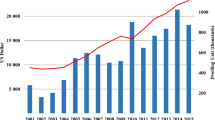Abstract
In this article, the methodological strengths and weaknesses of two common housing affordability indicators—the expenditure-to-income ratio and the residual income—are discussed, using data for the Belgian region of Flanders and the Netherlands. Affordability standards are used in order to distinguish the group facing affordability problems. In case of residual income, we use minimum budget standards—excluding housing—that allow for decent participation in society. For the expenditure-to-income ratio, we apply the internationally frequently used 30 % benchmark. Our comparison of the two methods results in a preference for the budget approach. Consequently, we explore the possibilities of applying the budget approach in a comparative context. We conclude by making recommendations for future research.


Similar content being viewed by others
Notes
Bramley (2012) however concludes that the ratio is probably the better single measure and the residual income measures are to be used in a supporting role. This statement needs to be regarded in the context of predicting self-reported payment problems of households. Also, the residual income measures that are tested are measures that are expressed relative to income, instead of absolute budgets, as are relevant in this study.
We realise that registration data on income are more reliable than surveyed data.
References
Bourassa, S. C. (1996). Measuring the affordability of home-ownership. Urban Studies, 33(10), 1867–1877.
Bradshaw, J. (Ed.). (1993). Budget standards for the United Kingdom. Aldershot: Avebury.
Bradshaw, J., & Mayhew, E. (2010a). The measurement of extreme poverty, Second Draft Final Report. York, The University of York: Social Policy Research Unit.
Bradshaw, J., & Mayhew, E. (2010b). Understanding extreme poverty in the European Union. European Journal of Homelessness, 4(December), 172–186.
Bramley, G. (2012). Affordability, poverty and housing need: triangulating measures and standards. Journal of Housing and the Built Environment, 27(2), 133–151.
Brounen, D., Neuteboom, P., & van Dijkhuizen, A. (2006). House prices and affordability—a first and second look across countries. Working paper, Amsterdam: DNB.
Burke, T., Stone, M., & Ralston, L. (2011). The residual income method: A new lens on housing affordability and market behaviour. Final Report, Melbourne: AHURI.
Cantillon, B., Lefebure, S., & Van den Bosch, K. (2009). De materiële levensomstandigheden van ouderen in Vlaanderen: Lessen uit Europa. In B. Cantillon, K. Van den Bosch, & S. Lefebure (Eds.), Ouderen in Vlaanderen en Europa. Tussen vermogen en afhankelijkheid. Leuven/Den Haag: Acco.
Capéau, B., & Pacolet, J. (2009). Vertel me niet hoe rijk je bent, ik zie de kleren die je draagt. In B. Cantillon, K. Van den Bosch, & S. Lefebure (Eds.), Ouderen in Vlaanderen en Europa. Tussen vermogen en afhankelijkheid. Leuven/Den Haag: Acco.
Chaplin, R., & Freeman, A. (1999). Towards an accurate description of affordability. Urban Studies, 36(11), 1949–1957.
De Decker, P., & Van Dam, R. (2005). De huisvestingsval. of wat huishoudens overhouden na het betalen van hun woonkosten. In: De Decker, P., Goossens, L., & Pannecoucke, I. (Eds.), Wonen aan de onderkant. Antwerpen, Apeldoorn: Garant, pp. 93–112.
Freeman, A., Kiddle, C., & Whitehead, C. (2000). Defining affordability. In S. Monk & C. Whitehead (Eds.), Restructuring housing systems: From social to affordable housing? (pp. 100–105). York: Joseph Rowntree Foundation.
Gabriel, M., Jacobs, K., Arthurson, K., Burke, T., & Yates, J. (2005). Conceptualising and measuring the housing affordability problem. Research Paper 1, Australian Housing and Urban Research Institute (AHURI), National research Venture 3.
Haffner, M. E. A., & Boumeester, H. J. F. M. (2010). The affordability of housing in the Netherlands: An increasing income gap between owning and renting? Housing Studies, 25(6), 799–820.
Hancock, K. E. (1993). Can pay? Won’t pay?’ or economic principles of ‘affordability’. Urban Studies, 30(1), 127–145.
Heylen, K., & Haffner, M. (2009). Inkomensongelijkheid en woonuitgaven in Vlaanderen en Nederland. Tijdschrift voor Sociologie, 30(2), 143–175.
Hulchanski, D. J. (1995). The concept of housing affordability: Six contemporary uses of the housing expenditure-to-income ratio. Housing Studies, 10(4), 471–492.
Kemp, P. (2007). Housing allowances in the advanced welfare states. In Kemp, P. A. (Ed.) Housing allowances in comparative perspective, Bristol: The Policy Press, pp. 265–287.
Maclennan, D., & Williams, R. (Eds.). (1990). Affordable housing in Britain and the United States. York: Joseph Rowntree Foundation.
Quigley, J. M., & Raphael, S. (2004). Is housing unaffordable? Why isn’t it more affordable? Journal of Economic Perspectives, 18(1), 191–214.
Saunders, P. (1998). Using budget standards to assess the well-being of families. Discussion Paper No. 93, Australia: Social Policy Research Centre (SPRC).
Soede, A., & Vrooman, C. (2008). Beyond the breadline. A poverty threshold based on a generalised budget approach. The Hague: The Netherlands Institute for Social Research SCP.
Stone, M. E. (2006a). What is housing affordability? The case for the residual income approach. Housing Policy Debate, 17(1), 151–184.
Stone, M. E. (2006b). A housing affordability standard for the UK. Housing Studies, 21(4), 453–476.
Storms, B., & Van den Bosch, K. (Eds.). (2009). Wat heeft een gezin minimaal nodig? Een budgetstandaard voor Vlaanderen. Leuven/Den Haag: Acco.
Thalmann, P. (2003). ‘House poor’ or simply ‘poor’? Journal of Housing Economics, 12, 291–317.
Waite, G., & Henman, P. (2005). Applying budget standards to assess housing affordability. In Paper presented at the national housing conference, Australia: Perth.
Wood, G. & Ong, R. (2011). Factors shaping the dynamics of housing affordability in Australia 2001–2006. Housing Studies, 26(7–8), 1105–1127.
Yates, J., & Milligan, V. (2012). Policies to support access and affordability of housing. In Smith, S. J., Elsinga, M., O’Mahony, L. F., Eng, O. S., Wachter, S., & Wood, G. (Eds.) International encyclopedia of housing and home, Vol. 5, Oxford: Elsevier, pp. 293–305.
Yip, N. M., & Lau, K. Y. (2002). Setting rent with reference to tenants’ affordability: public housing rent setting in Hong Kong. Journal of Housing and the Built Environment, 17, 409–418.
Acknowledgments
We would like to thank Gust Mariën (OTB-TU Delft) for calculating the results for the Netherlands.
Author information
Authors and Affiliations
Corresponding author
Rights and permissions
About this article
Cite this article
Heylen, K., Haffner, M. A ratio or budget benchmark for comparing affordability across countries?. J Hous and the Built Environ 28, 547–565 (2013). https://doi.org/10.1007/s10901-012-9325-2
Received:
Accepted:
Published:
Issue Date:
DOI: https://doi.org/10.1007/s10901-012-9325-2




